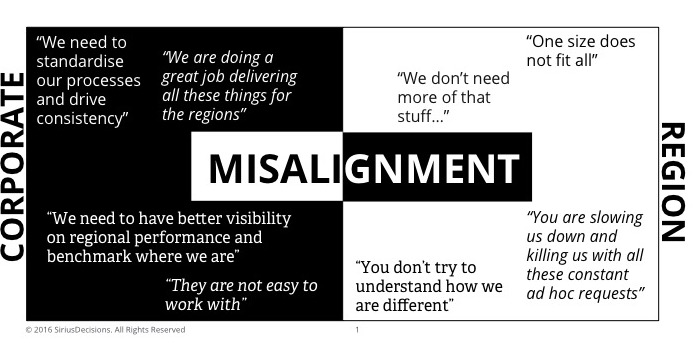Summit Europe 2016 Highlights: Helping Corporate and Regions Work Together
- The relationship between B2B companies’ corporate and region functions can be compared to the communication breakdowns of parents and kids
- To create harmony between corporate and regional groups, the Corporate-Regional Alignment Roadmap was introduced at Summit Europe 2016
- This roadmap explains how areas of responsibility should be aligned within four different phases of corporate-regional alignment
During their “Reimagining Corporate and Regional Interplay” presentation delivered today at Summit Europe 2016 in London, SiriusDecisions analysts Isabel Montesdeoca and Meta Karagianni likened the relationship between B2B companies’ corporate and region functions to the inevitable power struggles and communication breakdowns endured by parents and their children, as they constantly move toward independence. “They just don’t understand,” is a common message when a company’s corporate sales, marketing and product teams talks about their regional counterparts – and vice versa.
“This led us to wonder if corporate-regional friction is just a permanent fact of life, like being stuck forever in the teenage years on a bad day,” said Isabel. “Or can we imagine a world where the friction on bad days is reduced to a minimum and replaced by good days? To do that, we need to first understand the pain points that affect both corporate and regional teams and how these negatively impact alignment, resulting in friction.”
 The central and regional groups may be accustomed to chafing at their differences, but in today’s connected world, B2B companies need to mend these fences to stay competitive. Of course, what makes sense for one company may not work for another. To help organizations create harmony between corporate and regional groups, Isabel and Meta introduced the SiriusDecisions Corporate-Regional Alignment Roadmap. This detailed roadmap explains how key areas of responsibility should be aligned within four different phases of corporate-regional alignment, each of which is suitable for different situations:
The central and regional groups may be accustomed to chafing at their differences, but in today’s connected world, B2B companies need to mend these fences to stay competitive. Of course, what makes sense for one company may not work for another. To help organizations create harmony between corporate and regional groups, Isabel and Meta introduced the SiriusDecisions Corporate-Regional Alignment Roadmap. This detailed roadmap explains how key areas of responsibility should be aligned within four different phases of corporate-regional alignment, each of which is suitable for different situations:
- Phase one: Alignment led by corporate. This is the simplest, most straightforward phase. Corporate is the leader, focusing on strategy, while the regions focus on execution. This type of alignment is most suitable when market segment needs and go-to-market routes have a high degree of similarity.
- Phase two: Alignment influenced by regional priorities. In this phase, regions have developed some region-specific priorities, but for this approach to succeed, corporate must ensure that its overall strategy takes those regional priorities into account and is capable of supporting them.
- Phase three: Alignment enables the distribution of ownership. In this phase, the corporate-regional relationship provides a level of independence for the region in key areas that affect its ability to respond quickly and effectively to its market’s needs. Regions are empowered to manage their own initiatives, but they must follow corporate guidelines. Corporate supports and monitors these efforts.
- Phase four: Alignment supports situation-specific distribution of ownership. In this phase, the corporate-regional relationship resembles a partnership. Responsibility for a strategy or initiative may be primarily driven by corporate or the region, depending on its requirements for success. This approach enables corporate and regions to leverage each other’s strengths to grow the business.
As corporate and regional alignment is not static, both parties need to make sure they prepare for the journey. Meta emphasized the importance, in all phases of corporate-regional alignment, of corporate and regional teams working together to establish a culture of openness and trust. She also highlighted a number of key actions that organizations should take to improve their corporate-regional alignment, including the creation of a new vision of leadership for both sides that puts aside traditional hierarchies, and establishing new ways of operating together with clear objectives, goals and direction.

Editor’s Note: For more information about Summit Europe 2016, click here. For information about upcoming SiriusDecisions events, visit SiriusDecisions’ events page.